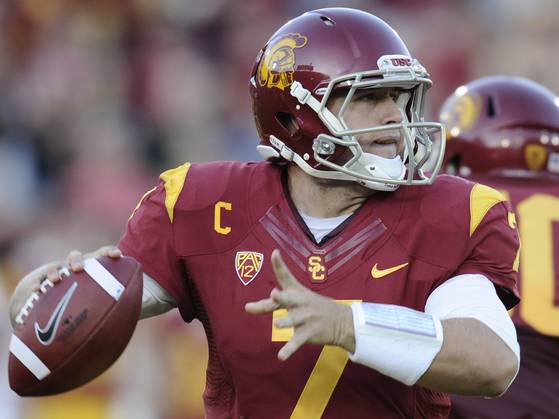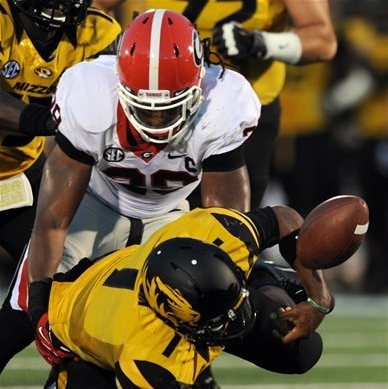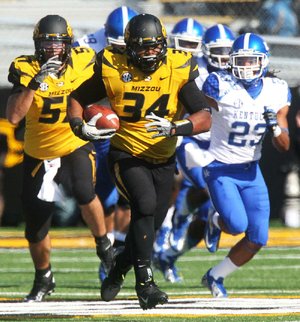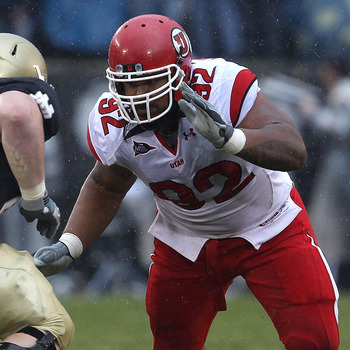
Despite some difficult moments this year, a quarterback like Matt Barkley could still go #1 overall
The draft is a slightly different animal since the new CBA was signed. The rookie wage cap has revolutionised the NFL, making the #1 pick a worthwhile possession rather than a hindrance. Sam Bradford – the final #1 overall pick before the new rules kick in – signed a contract worth $78m with $50m in guarantees. With an updated CBA in place, Cam Newton and Andrew Luck both agreed deals worth a fully guaranteed $22m. Teams don’t need to fear a JaMarcus Russell-style titanic mistake anymore.
With that in mind, there’s scope for a bad team to do whatever it takes to get a kick start. Indianapolis choosing Andrew Luck was pretty much a no-brainer. Carolina drafting Cam Newton? Not so much.
The Panthers had the #1 pick but no quarterback. They could’ve gone in many different directions. Lot’s of pundits had them taking Nick Fairley, a defensive tackle. Or Von Miller, a pass rusher. Or Patrick Peterson, a cornerback. In the end, they decided they needed a quarterback at all costs. They went through the list (four quarterbacks were taken in the first twelve picks) and chose Newton. That was point one of the rebuild. Like many teams, the Carolina Panthers were going to build around a quarterback.
Which team would’ve taken Newton had Carolina gone with, for example, Von Miller? I would guess he’d still be on the board at #8 where Tennessee took Jake Locker. He may have survived beyond that.
I think there are similarities between 2011 and the forthcoming draft in April. There are a handful of really talented defensive prospects. There isn’t a clear ‘superstar’ quarterback gaining rave reviews like Andrew Luck or Robert Griffin III. If the Kansas City Chiefs have the #1 pick they’ll be in the same situation as Carolina. They’ll face a choice of best player vs a launch pad quarterback. And I suspect they’ll take a quarterback.
The question would become who do they take? Newton was an easier choice in 2011 due to his outstanding physical talents. Matt Barkley, Geno Smith, Tyler Wilson etc don’t boast those same qualities. Yet anyone watching the Chiefs recent defeat to Pittsburgh can identify where Kansas City’s problems lie. They don’t have a terrible roster. They’ve got some nice pieces on defense and some playmakers on offense. They compete in a pretty open AFC West division. They just need a quarterback who can bring everything together.
While I accept none of the quarterbacks eligible for 2013 probably deserves to be the #1 overall pick based 0n performance this year, I think it’s stll likely to be the direction Kansas City goes if they have the choice.
When we get into December I’ll start the weekly mock draft updates and we’ll run through different alternatives for the Seahawks. For now, I’m sticking with the same pick as last time. This offense continues to utilise the run as its focus and that will always be the case with Pete Carroll as Head Coach. He appears to want a big strike passing game and Darrell Bevell is becoming increasingly creative to make that happen. Across the board they like multi-faceted athletes who can contribute in a number of different ways. So the pick once again this week is Tennessee’s Cordarrelle Patterson.
Receiver is considered less of a need nowadays, but the Seahawks could still use another playmaker. I did consider Arthur Brown (LB, Kansas State) – a player Carroll is familiar with. I also considered the remaining defensive tackles, Robert Woods, the two Stanford tight ends and cornerback Jonathan Banks. However, I do think they’ll look at ways to aid Wilson’s progression in year two. A receiver in Seattle might only make two passes in a game, but he’ll come away with 50-60 yards and a touchdown. That’s the big strike passing offense for you. Patterson has got the potential to be a home run hitter – to make two big plays in a game if not the 10-catch performance we’re unlikely to ever see in this system.
I’ve included a round two at the bottom. Please don’t read too much into the selections there – it’s really just a review of the next tier of prospects.
Updated first round mock draft
 |
#1 Matt Barkley (QB, USC) Watching KC’s game against Pittsburgh, it’s obvious this team needs a quarterback. They need to identify which is the best and draft them. |
 |
#2 Damontre Moore (DE, Texas A&M) He’s been incredible this year and leads the NCAA with 12.5 sacks. The Jaguars have no pass rush. |
 |
#3 Jarvis Jones (DE, Georgia) Explosive playmaker but there are some concerns about his health following the injury that led to his departure from USC. |
 |
#4 Sheldon Richardson (DT, Missouri) Prototypical three technique interior pass rusher. The Panthers run a variety of 4-3 and 3-4 looks but Richardson can adapt to both. |
 |
#5 Geno Smith (QB, West Virginia) Buffalo’s GM keeps telling the media Ryan Fitzpatrick isn’t a franchise quarterback. So it’s not hard to guess what they might do here. |
 |
#6 Chance Warmack (G, Alabama) The Raiders just need to start drafting good football player. Warmack will be a top NFL guard in year one. |
 |
#7 Luke Joeckel (T, Texas A&M) He’s played well enough this year to move into top ten consideration. |
 |
#8 Jonathan Cooper (G, North Carolina) The Eagles need to sort out their offensive line. Cooper is athletic enough to play tackle or guard. |
 |
#9 Barkevious Mingo (DE, LSU) If the Jets do go defense here, Mingo makes a lot of sense. They need a great edge rusher. |
 |
#10 Alec Ogletree (LB, Georgia) Incredible athlete with untapped potential as a pass rusher. Ogletree could be great. There are some off-field concerns. |
 |
#11 Star Lotulelei (DT, Utah) Huge upside but he can be very inconsistent. |
 |
#12 Manti Te’o (LB, Notre Dame) Great player with a few lingering off-field concerns. On the field though he’s a leader and a playmaker. |
 |
#13 Dee Milliner (CB, Alabama) Anyone who gets Dee Milliner outside the top ten is getting the steal of the draft. |
 |
#14 Bjoern Werner (DE, Florida State) He needs to add weight again. At his 2011 size he’s a J.J. Watt clone. That’s his ceiling. |
 |
#15 Brandon Coleman (WR, Rutgers) If he declares (big if) he’ll be by far the most talented receiver in the 2013 draft. |
 |
#16 Ezekiel Ansah (DE, BYU) Ansah will test well at the combine and work his way into the top-20 picks. |
 |
#17 Jake Matthews (T, Texas A&M) He could be better than team mate Luke Joeckel, but doesn’t get quite as much credit playing right tackle. |
 |
#18 Dion Jordan (DE, Oregon) Amazing athlete who’s still learning to become a rounded pass rusher. |
 |
#19 Bradley Roby (CB, Ohio State) He’s gradually overtaken Jonathan Banks as the #2 ranked corner in this class. |
 |
#20 C.J. Mosley (LB, Alabama) It’s the same thing every week – C.J. Mosley making big plays for Alabama. |
 |
#21 Matt Elam (S, Florida) Top-15 talent who lasts this long only due to a lack of need earlier. Elam’s a true playmaker in the secondary. |
 |
#22 Cordarrelle Patterson (WR, Tennessee) Multi-faceted playmaker who will score touchdowns in many different ways. He’s also 6-3 with electric speed. |
 |
#23 Zach Ertz (TE, Stanford) The Steelers can afford to draft a tight end here and Ertz is getting a lot of top-20 talk at the moment. |
 |
#24 Jonathan Jenkins (DT, Georgia) If you need a guy to build a 3-4 defense around, here’s you man. |
 |
#25 Johnathan Hankins (DT, Ohio State) Secondary is a bigger need but the value doesn’t fit here. Hankins is scheme diverse. |
 |
#26 Sylvester Williams (DT, North Carolina) He’s only still on the board due to age. Former JUCO transfer approaching his mid-20’s. |
 |
#27 Robert Woods (WR, USC) He’s a better player than this placing. Expect Woods to land on a good team that can look for value. |
 |
#28 Jesse Williams (DT, Alabama) Williams is the kind of player that belongs on a team with attitude. |
 |
#29 John Simon (DE, Ohio State) Blue collar player that’ll boost Baltimore’s pass rush. |
 |
#30 Dallas Thomas (G, Tennessee) Thomas was so impressive against South Carolina and Jadeveon Clowney. He could play tackle or guard. |
 |
#31 Tavon Austin (WR, West Virginia) He’s a playmaker and Houston could shoot for value here. |
 |
#32 Levine Toilolo (TE, Stanford) Putting a 6-8 red zone threat alongside Julio Jones and Roddy White makes sense to me. |
Possible round two
#33 Jacksonville – Taylor Lewan (T, Michigan)
#34 Kansas City – Jonathan Banks (CB, Mississippi State)
#35 Carolina – Xavier Rhodes (CB, Florida State)
#36 Buffalo – Justin Hunter (WR, Tennessee)
#37 Philadelphia – Sam Montgomery (DE, LSU)
#38 Washington – Arthur Brown (LB, Kansas State)
#39 New York Jets – Eric Fisher (T, Central Michigan)
#40 Cincinnati – Giovani Bernard (RB, North Carolina)
#41 St. Louis – Oday Aboushi (T, Virginia)
#42 Tennessee – Kenny Vaccaro (S, Texas)
#43 San Diego – Brennan Williams (T, North Carolina)
#44 Miami – Keenan Allen (WR, California)
#45 Dallas – Tyler Wilson (QB, Arkansas)
#46 Arizona – Tyler Bray (QB, Tennessee)
#47 Detroit – Jordan Poyer (CB, Oregon State)
#48 Cincinnati – Chase Thomas (LB, Stanford)
#49 Tampa Bay – Shawn Williams (S, Georgia)
#50 Minnesota – Shariff Floyd (DT, Florida)
#51 New York Giants – Tyler Eifert (TE, Notre Dame)
#52 Seattle – Gavin Escobar (TE, San Diego State)
#53 Miami – Corey Lemonier (DE, Auburn)
#54 Pittsburgh – Cornellius Carradine (DE, Florida State)
#55 New England – Markus Wheaton (WR, Oregon State)
#56 Green Bay – Jawan Jamison (RB, Rutgers)
#57 Denver – Khaseem Greene (LB, Rutgers)
#58 San Francisco – Alex Okafor (DE, Texas)
#59 Chicago – Bennie Logan (DT, LSU)
#60 Baltimore – Eddie Lacy (RB, Alabama)
#61 Houston – T.J. McDonald (S, USC)
#62 Atlanta – Kawann Short (DT, Purdue)







